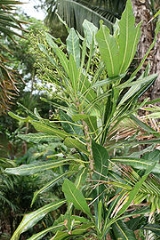
Meryta latifolia
Encyclopedia
Meryta latifolia is an evergreen
tree
endemic to Norfolk Island
, Australia
, where it occurs in subtropical moist forest conditions. Its common name is Broad-leaved Meryta.
Convicts apparently used the large leaves to wrap up dough to bake in ashes.
, with huge broad leaves, which can withstand frosts down to -2C once established.
Evergreen
In botany, an evergreen plant is a plant that has leaves in all seasons. This contrasts with deciduous plants, which completely lose their foliage during the winter or dry season.There are many different kinds of evergreen plants, both trees and shrubs...
tree
Tree
A tree is a perennial woody plant. It is most often defined as a woody plant that has many secondary branches supported clear of the ground on a single main stem or trunk with clear apical dominance. A minimum height specification at maturity is cited by some authors, varying from 3 m to...
endemic to Norfolk Island
Norfolk Island
Norfolk Island is a small island in the Pacific Ocean located between Australia, New Zealand and New Caledonia. The island is part of the Commonwealth of Australia, but it enjoys a large degree of self-governance...
, Australia
Australia
Australia , officially the Commonwealth of Australia, is a country in the Southern Hemisphere comprising the mainland of the Australian continent, the island of Tasmania, and numerous smaller islands in the Indian and Pacific Oceans. It is the world's sixth-largest country by total area...
, where it occurs in subtropical moist forest conditions. Its common name is Broad-leaved Meryta.
Description
M. latifolia is a tree 5–6 m tall, with single trunk or with few branches towards top, with brittle wood. The leaves are broadly oblanceolate, 50 to 75 cm long, 25 to 30 cm broad, gradually narrowed and finally rounded at base, obtuse to rounded at apex. The female inflorescence is terminal, paniculate, 10 to 15 cm long, and densely clustered. The fruit is round, 5 to 6 mm long, bluntly 5 or 6-ribbed.Convicts apparently used the large leaves to wrap up dough to bake in ashes.
Distribution and status
M. latifolia occurs only on Norfolk Island, and is considered critically endangered because it is dioecious, having separate male and female plants. The total number of mature individual plants is less than 150, the effective reproductive population limited by the number of surviving female plants, which number approximately 20. It occurs on ten sites on Norfolk Island, but most of these contain only one or two plants and only one site has more than 13. Although one site contains approximately 115 trees, regeneration is not occurring at this site. Continuing declines in the number of mature individuals, and number of locations and subpopulations are projected for several reasons including: lack of formal protection or management programs, the vulnerability of small populations to stochastic disturbance events (eg cyclones), ongoing competition with invasive weeds, predation by rats, senescence of over-mature plants, and sex ratio bias. The species is adapted to moist forest conditions and is therefore susceptible to unfavourable climate change (projected increases in the incidence of drought and extreme rainfall events that cause physical damage).Cultivation
Rare in cultivation, M. latifolia may be grown fairly easily in warm frost-free climates like those of Sydney, Australia, or Florida in the United States. A slightly hardier alternative is the New Zealand Puka tree, M. sinclairiiPuka (tree)
Puka or Pukanui is a large-leaved evergreen tree endemic to New Zealand that grows to about 8 m tall, with the distinctly tropical appearance typical of the genus. There are about 27 species of Meryta, all small, resinous trees of the subtropical and tropical Pacific Ocean.Puka occurs naturally...
, with huge broad leaves, which can withstand frosts down to -2C once established.
See also
- MerytaMerytaMeryta is a genus in the flowering plant family Araliaceae. There are 27 species in the genus, all small, resinous trees of the subtropical and tropical Pacific Ocean, characterized by huge, simple leaves and a dioecious sexual system, a unique combination in Araliaceae. Meryta has its center of...
- Meryta denhamiiMeryta denhamiiMeryta denhamii is an evergreen tree endemic to New Caledonia, where it occurs in dense humid forest.-Description:M. denhamii grows to about 6m tall. The large, stiff, leathery leaves are elongated, curved at the edges and appear in tufts or bunches at the ends of the branches. Their central rib...
- Meryta sinclariiPuka (tree)Puka or Pukanui is a large-leaved evergreen tree endemic to New Zealand that grows to about 8 m tall, with the distinctly tropical appearance typical of the genus. There are about 27 species of Meryta, all small, resinous trees of the subtropical and tropical Pacific Ocean.Puka occurs naturally...

